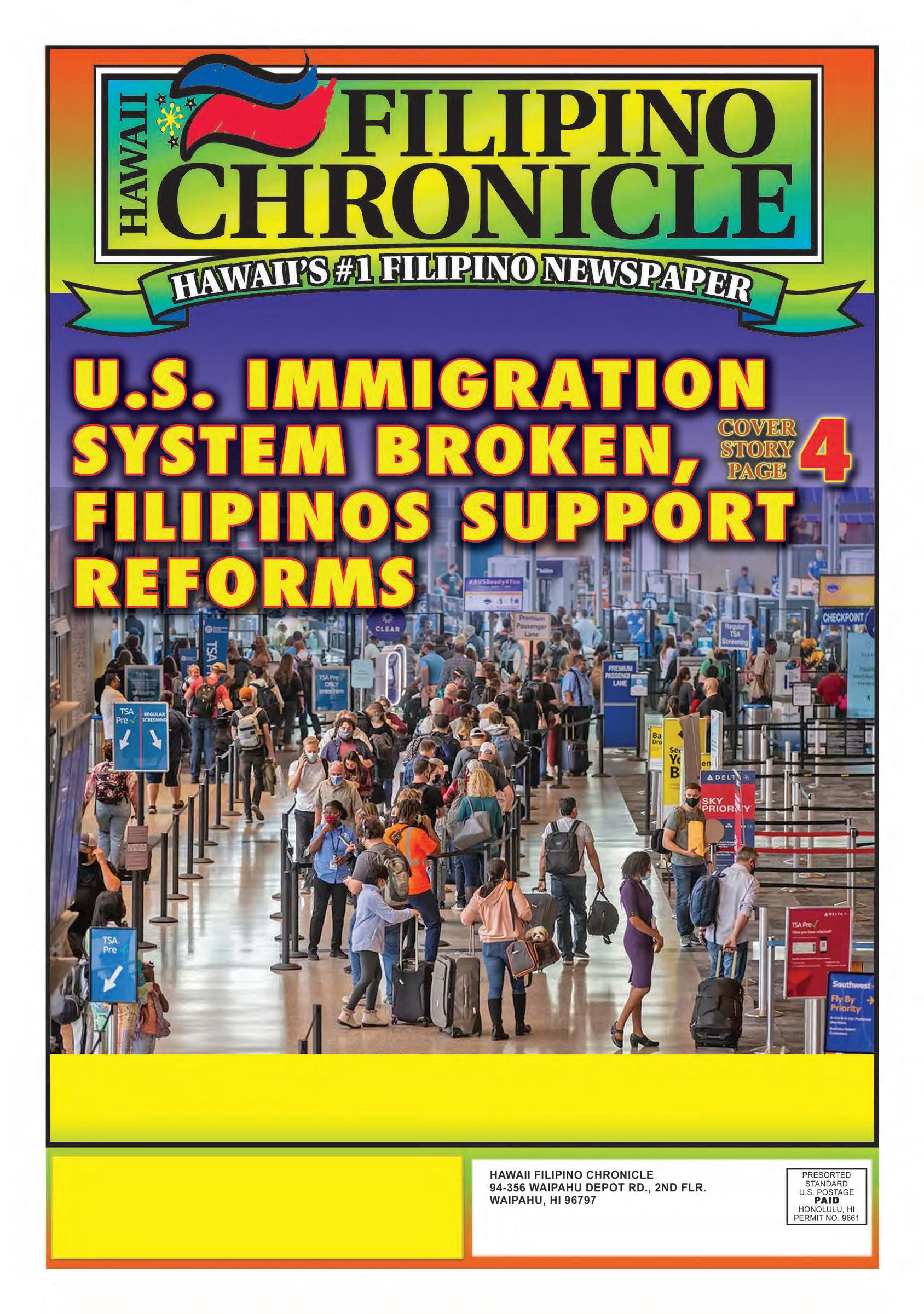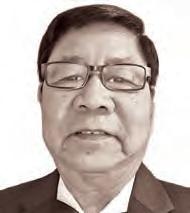CANDID PERSPECTIVES coNSeRVAtIVe ScotuS teASeS uS oN AffIRmAtIVe ActIoN, RAcIAL equALIty


OPEN FORUM

HAwAII VoteRS ARe tHe Key to StoppINg coRRuptIoN

HAWAII WORKERS CORNER LooK out foR tHe pINK INSuRANce eNVeLope!

THEATRICAL REVIEW KASARINLAN: A JouRNey to INdepeNdeNce

JULY 1, 2023
There is a Glimmer of Hope for Passing Immigration Reform in the 2023 Dignity Act
It’s high time and long overdue that comprehensive immigration reform finally be enacted and both Democrats and Republicans must make concessions. Both parties in principle agree that immigration reform is needed but they have differing priorities in some areas and actual common ground in many others which is why it’s mindboggling that meaningful reform has not be accomplished in close to four decades.
It’s fair to say that inaction on immigration over these decades is not entirely due to contentious impasse. Perhaps in the first 15 years since the last overhaul, there was no urgency for further action. As we know, major policy takes time to implement and for a new work culture with these changes to settle in.
Following those 15 or so years up to the present, inaction on immigration could be attributed to the increasing partisanship politics and increasing caustic power struggle in D.C. – wherein the party not in power, does not want to make it easy for the party in power to keep their power by handing over legislative accomplishments. It’s a vicious pattern, but has been symptomatic D.C. politics for some time and a reason why little gets done, including reforms to immigration.
But some legislation must be passed, right? In the very few things that do get done, it’s a result of the core leadership in the House and Senate prioritizing their top items they want accomplished and using their political capital (kind of like an IOU) to make it happen.
So now we’re looking at immigration reform competing against vital budget items, Social Security, Medicare, health care, education, military funding, veterans’ benefits, pet projects, and so on. And in that environment, the urgency of immigration reform somehow in lawmakers’ prioritization suddenly doesn’t seem as “urgent.”
This phenomenon – of immigration reform getting lost in the mix of prioritization – perhaps can explain Democrats and Republicans’ (up to the Bush era) inaction to overhaul immigration.
But added to this somewhere beginning from the birth of the now defunct Tea Party and current Trumpism – collectively seen as the rise of populist right movement in the U.S. – xenophobia has become election mint and the top or close to the top reason why right-wing politicians in red states, especially those along or close to the southern border, get elected.
That xenophobia in the form of policy is the adoption of hardline positions on immigration. Suddenly it’s become extremely difficult to negotiate immigration reform on policy alone. In the Bush era and to some factions of business-minded Republicans today, they’ve been receptive to many of the immigration reforms Democrats support and understand that immigrants are good for our economy and communities.
But if you remember while Trump was president, his idea of immigration reform was gutting the foundational core of immigration from being family-based immigration to merit based immigration. He wanted to mandate English proficiency. He wanted to do away with (and still wants to) get rid of the 14th Amendment or birthright citizenship. He came up with all kinds of formulas and quotas that his entire agenda on immigration was to drastically reduce the numbers of immigrants and essentially stop family-based immigration. And of course, there was the failed border wall fiasco.
It is during this period and perhaps some years prior (again with the Tea Party) when policy really became a sticking point and root to impasse (as opposed to not prioritizing immigration
FROM THE PUBLISHER
Hawaii has a rich history of immigration. Today our Filipino community is the fastest and largest growing immigrant group in Hawaii. Nationally, Filipino immigrants are the fourth largest immigrant group, behind Mexico, India and China. The U.S. Census Bureau shows the Asian population growth in the U.S. in 2022 was the fastest at a 2.4% increase. The biggest propeller of this growth stems from immigration. Two-thirds of the Asian population growth (577,000) was linked to immigration last year. It’s apparent based on statistics alone that immigration is an issue of importance and interest in our community.
For our cover story this issue, associate editor Edwin Quinabo reports the latest on Immigration Reform. The last comprehensive immigration bill was passed in 1986 and immigrant advocate groups, immigrants and politicians are demanding that it’s high time for our immigration system to be updated. There are two comprehensive immigration bills currently in Congress. One is a partisan bill that the Republican-majority House passed but will not move an inch further. But there is a bipartisan bill called the Dignity Act that has a glimmer of hope to gain traction. Unfortunately, that bill doesn’t include reforms to Family-based immigration. This area of immigration is important to our community because most Filipinos in the U.S. who obtain lawful permanent residence do so through family reunification channels and getting a green card. But the Dignity Bill aims to streamline the H-2A guestworker program, an area of interest for our community. Get more details in the story as well as comments from our Filipino community.
Also in this issue our columnists cover several interesting topics:
1) Emil Guillermo writes “Conservative SCOTUS Teases Us on Affirmative Action, Racial Equality;” 2) Dr. Belinda Aquino provides us with a feature article on “The Need To Understand Philippine Independence History;” 3) Rose Cruz Churma gives us a theatrical review “KASARINLAN: A Journey to Independence;”
(we have an accompanying Feature News written by our staff on that same production; 4) Seneca Moraleda-Puguan writes “Lost at Sea,” about the loss of five lives due to a catastrophic implosion of a submersible bound to the Titanic wreck site.
We have contributions from Keli‘i Akina who writes “Hawaii Voters Are the Key to Stopping Corruption;” and Sheryll Bonnilla, Esq. gives us informative legal information in her “Understanding Wills.”
This issue we begin a new column series called Hawaii Workers Corner which will be presented by our newest columnist Dr. Arcelita Imasa and the Hawaii Workers Center. The column will cover topics that promote and protect workers’ rights and improve the living and working conditions of Hawai’i’s workers. Dr. Imasa is a practicing family physician and the secretary of the Hawaii Workers Center’s Executive Committee of the Board. She grew up in the Philippines before migrating to Hawaii with her family more than a decade ago. Welcome aboard Dr. Imasa.
We hope you enjoy this issue. Remember HFC is published online at www.thefilipinochronicle.com for your convenience.

Thank you for supporting the Hawaii Filipino Chronicle. Until the next issue,warmest Aloha and Mabuhay!

reform). There are others who will argue that the U.S. was always xenophobic, which is true, but that doesn’t explain why the policies implemented over the close to four decades since the last immigration reform were kept lawful and enabled millions of immigrants to continue entering the U.S.
We already saw what Trump wanted to do as president with immigration reform. Immigrant communities should also be aware that second place presidential candidate for the Republican party Gov. Ron DeSantis echoes many of those same xenophobic policies Trump has and is doing.
What has a chance of passing in 2023?
2023 has two major immigration reform bills. The Republican-majority House passed one, which is so narrow – mostly
Publisher & Executive Editor
Charlie Y. Sonido, M.D.
Publisher & Managing Editor
Chona A. Montesines-Sonido
Associate Editors
Edwin QuinaboDennis Galolo
Contributing Editor
Belinda Aquino, Ph.D.

Design
Junggoi Peralta
Photography
Tim Llena
Administrative Assistant
Lilia Capalad
Editorial & Production Assistant
Jim Bea Sampaga
Columnists
Carlota Hufana Ader
Rose Cruz Churma
Elpidio R. Estioko
Willie Espero
Perry Diaz
Emil Guillermo
Arcelita Imasa, M.D.
Seneca Moraleda-Puguan
J.P. Orias
Charlie Sonido, M.D.
Emmanuel S. Tipon, Esq.
Contributing Writers
Clement Bautista
Edna Bautista, Ed.D.
Teresita Bernales, Ed.D.
Sheryll Bonilla, Esq.
Serafin Colmenares Jr., Ph.D.
Linda Dela Cruz
Carolyn Weygan-Hildebrand
Amelia Jacang, M.D.
Caroline Julian
Raymond Ll. Liongson, Ph.D.
Federico Magdalena, Ph.D.
Matthew Mettias
Paul Melvin Palalay, M.D.

Renelaine Bontol-Pfister
Seneca Moraleda-Puguan
Mark Lester Ranchez
Jay Valdez, Psy.D.
Glenn Wakai
Amado Yoro
Philippine Correspondent:
Greg Garcia
Neighbor Island Correspondents:
Big Island (Hilo and Kona)
Grace LarsonDitas Udani
Kauai
Millicent Wellington
Maui
Christine Sabado
Big Island Distributors
Grace LarsonDitas Udani
Kauai Distributors
Amylou Aguinaldo
Nestor Aguinaldo
Maui Distributors
Cecille PirosRey Piros
Molokai Distributor
Maria Watanabe
Oahu Distributors
Yoshimasa Kaneko
Shalimar / Jonathan Pagulayan
Advertising / Marketing Director
Chona A. Montesines-Sonido
Account Executives
Carlota Hufana Ader
JP Orias
2 HAWAII FILIPINO CHRONICLE JULY 1, 2023 EDITORIAL
(continue on page 3)
It’s a Banner Year for Filipino Chefs in the Prestigious James Beard Awards, Congrats to All Winners and Nominees
Filipino cuisine is a big part of Filipino culture. Slowly but surely, we see our cuisine’s popularity growing especially in communities with large Filipino populations in California, Hawaii, New York-New Jersey, Nevada and Washington state.
Spearheading this movement, the Filipinization of Pinoy cuisine into the mainstream American culinary landscape, are the bold restauranteurs and chefs willing to take the risk in bringing this burgeoning ethnic food to the masses with their Filipino restaurants.
The restaurant business is already super competitive and risky to begin with. So, these Filipino restauranteurs and
chefs deserve our community’s support and respect for their valiance to put so much at stake personally to help promote our cuisine and culture.
James Beard Foundation 2023 winners
We’re so pleased that the industry’s elite responsible for the James Beard Awards, the Oscars equivalent in the food and hospitality industry, are taking notice of our Filipino chefs and restaurants.
This year is a breakthrough banner year for Filipinos. The 2023 James Beard Award Chef and Restaurant Winners include three Filipino American restaurants-chefs, two nominees apart from the three who won, and a FilAm winner of the
wants more funding for border security and the continuation of building a southern border wall – that President Joe Biden said he would veto it. The U.S. Senate will not even work with the House on that bill.
There could be a hail Mary chance of passing a bipartisan bill introduced by Reps. María Elvira Salazar (R-FL) and Veronica Escobar (D-TX) not that long ago called the Dignity Act. It’s not comprehensive to the extent that includes family-based green cards.
But it addresses border security that Republicans and also many Democrats want by providing $25 billion in border security.
It would mandate a nationwide E-verify system to ensure all American businesses are hiring legal workers – something Republicans and some Democrats favor.
It will make changes to the asylum process like rapidly expediting the decision-making of asylees’ cases and putting an end to catch-and-release – something Republicans could support and some Democrats.
It proposes more order at the border that would require all asylum seekers to go through legal ports-of-entry. If an immigrant is caught twice trying to sneak in at a non-port-of-entry then declare they are seeking asylum, they would not be able to declare asylum in the future. Republicans certainly would want tougher action.
It establishes a Dignity Program, a practical solution for undocumented immigrants who have been in the U.S. for more than five years to be eligible for a seven-year process that would allow them to work, pay restitution, and earn legal status. Republicans would be hard pressed to agree with this provision.
It seeks to improve the country’s current Guest Worker program – something both parties can support.
Big picture assessment, this largely is a Republican-leaning bill on immigration reform, and it actually might be difficult for the lead Democrat to get her colleagues on board, if anything. It’s not comprehensive enough, but it is worth supporting, if negotiations do not alter the features too dramatically from what they are currently.
A positive outlook -- at least the 2023 GOP proposal is not the disastrous piece of legislation that Trump wanted passed while in office. Let us advocate for comprehensive immigration reform that balances both human rights and dignity with the needs and values of the host (our) communities. In this search for balance, we should be guided by dignity, respect and fairness.
James Beard Award in the social media category (promoting food).
Genevieve Villamora, a judge in this year’s James Beard Awards, said “A younger generation of Filipino Americans in the restaurant industry is having more confidence to have their restaurant be a Filipino restaurant instead of, like, a French bistro or, like, a pasta-wine bar.”
Tim Flores and Genie Kwon (husband and wife), owners and chefs of the Filipino restaurant Kasama in Chicago won in the Best Chef: Great Lakes (Il, IN, MI, OH) category. Kasama is one of only a handful of Michelin-starred Filipino restaurants in the world. Last year, Tim and Genie were also named Food & Wine’s Best New Chefs. They recently appeared this year on Good Morning America during Asian Week to demonstrate their version of chicken adobo. Kasama is unique. In the day it is part fast-casual operation, part bakery. And at night, it transforms into a fine-dining restaurant that takes Filipino cuisine to the highest level. An example of Flores’ artistry is his theatrical version of kinilaw. Flores cures raw fish with calamansi vinegar, drizzles it with a fruity olive oil, tops it with golden caviar pearls – then smokes the entire dish.
Margarita Manzke of restaurant Republique in Los Angeles won in the category Outstanding Pastry Chef or Baker. Born and raised in the Philippines, Margarita Manzke opened several award-winning concepts in Los Angeles, including République, Petty Cash Taqueria, Sari Sari Store, Bicy-
clette, and Manzke. République has continued to make its mark on the culinary landscape of Los Angeles as a frequent entry on the Los Angeles Times “101 Best” List and one of Restaurant Critic Bill Addison’s most recommended LA restaurants to both friends and readers. In addition to her other restaurants, Manzke is well known for her Sari Sari Store in the historic Grand Central Market.
Marilou Ranta, chef/owner of Filipino fine-dining restaurant the Quarry in Maine won in the Outstanding Hospitality category. This category not only recognizes a restaurant that fosters a sense of hospitality among its customers and staff but must also demonstrate consistent excellence in food. Ranta grew up on the island of Mindanao in the Philippines and worked as a maid. She opened the Quarry in 2018.
Erwan Heussaff, content creator won the broadcast media award in the social media category for his Instagram account @erwan. He is the founder of The Fat Kid Inside Studios which runs the YouTube channel FEATR, which has a focus on Philippine cuisine and culture.
Nominees: The 2023 nominees were Vince Bugtong chef/ owner of Abaca in San Francisco, in the Outstanding pastry Chef or Baker category and Aaron Verzosa chef/owner of Archipelago in Seattle who was up for Best Chef: Northwest and Pacific.
In 2022, there were five James Beard Award nominations for Filipino Americans from Seattle, Oakland, Asheville, N.C. and Los Angeles. None of the nominees won last year.
In 2021-2020, Filipinos
Dale Talde of Goosefeather in Tarrytown, NY was up for the Best Chef: New York State, while five Fil-Am chefs duked it out for the Best Chef: Northwest and Pacific (AK, HI, OR, WA) award – Carlo Lamagna, Magna Kusina (Portland, OR); Melissa Miranda, Musang (Seattle); Sheldon Simeon, Tin Roof (Kahului, HI); Jojo Vasquez, Fond (Lahaina, HI); and Aaron Verzosa, Archipelago (Seattle).
In 2019, FilAm Tom Cunanan won the James Beard Award in the Best Chef: Mid-Atlantic category for his work at Bad Saint in Washington.
In 2019, FilAm Sheldon Simeon from Hawaii, a Top Chef finalist, had his restaurant Lineage in Maui nominated for a James Beard Award for Best New Restaurant.
Congratulations to this year’s and former winners, and all the nominees of the James Beard Awards. Your work are important contributions to our community’s collective Filipino-American experience and helps to promote our food and culture to the rest of America.
Thank you to the James Beard Foundation for recognizing these chefs.
We encourage our readers and community to continue to support our Filipino restauranteurs and chefs on the mainland and locally. If you think you’ve tried them all in Hawaii, there is at least one new Filipino restaurant we’re aware of in Ward that’s worth trying. Spread the word among your family and friends of all the Filipino food establishments you’ve enjoyed. This is how we can support each other. Mabuhay to our Filipino chefs and restaurateurs.

JULY 1, 2023 HAWAII FILIPINO CHRONICLE 3 EDITORIAL
(There is.....from page 2)
Two Immigration Reform Bills in 2023 Congress, Will Updating Immigration Finally Happen?
By Edwin Quinabo
It’s long overdue that the country’s immigration system be updated and modernized, most politicians on both sides of the political spectrum can agree on this.
But according to Pew Research Center, Republicans and Democrats differ over the most pressing priorities for immigration, which some politicos say is the root of the decades-long inaction on this issue.
Congress hasn’t passed a comprehensive reform bill since 1986. This impasse to get legislation done have many immigrant advocates and politicians saying this is the reason why the current immigration situation has become dire, urgent, chaotic and unjust. A snapshot of the current immigration situation include:
* As of June 2023, approximately 16.8 million illegal immigrants reside in the United States, according to FAIR. This is significantly higher than their January 2022 illegal immigrant population estimate of 15.5 million. This rise comes as the number of people apprehended for illegally crossing the southern border has reached record annual levels. Rise in both illegal entry and arrests suggests a greater need for more border enforcement resources and new opportunities to enter legally.
* Economic globalism and climate change – among some pressing reasons -- have led to increasingly harsh conditions (in some cases that include persecution) in developing countries that have spiked the number of asylum-seeking immigrants at the U.S. southern border. This has put an economic strain on American border cities and the large cities where these asylum-seekers eventually settle until their case is decided. City-state governments across the nation have been calling on the federal government (immigration is a mostly federal issue) for financial support and action on immigration reform.
* More than 4 million relatives of U.S. citizens and permanent residents are stuck in Green Card backlogs, according to the State Department. This means millions of families are separated, often waiting for years, before they can be reunited.

* Labor shortages in several industries from high tech to crop picking-farming that could be filled by immigrant guest workers but aren’t due to an outdated guest worker program are keeping the U.S. economy from growing, industry experts and Chambers of Commerce across the nation say.
All of these areas of immigration – illegal entry and enforcement, adjusting asylum laws, family-based green card backlogs and employment-guest workers visas – must be acted on by Congress for a more permanent solution. Executive orders are temporary band-aid attempts to immigration and limited in scope, experts say.
But urgency hasn’t sparked action, even in the rare cases where either Democrats or Republicans have had control of both houses of Congress and the presidency at the same time (unified government or single-party rule), immigrant advocates say. Most recently Presidents Barack Obama and Donald Trump enjoyed a unified government but failed to update immigration.
Such missed opportunities under single-party rule have the most cynical political observers questioning if in fact Republican politicians want immigration problems solved considering how much they rely on them for votes (using scare tactics) or that Democrat politicians really do not prioritize immigration matters enough that they keep placing immigration behind other issues. Trump exploited the illegal immigrant “horde invasion;” while Obama used up most of his political capital on healthcare.
But has the time finally come for action? Will 2023 be a breakthrough year for immigration reform?
The Republican-majority House this
year passed an immigration reform bill that President Joe Biden vowed to veto. House Speaker Kevin McCarthy said the GOP bill could spark bipartisan negotiations, meaning it is a start, a bill that could be worked on.
There is another comprehensive immigration reform bill, a bipartisan bill called the Dignity Act, led by Reps. María Elvira Salazar (R-FL) and Veronica Escobar (D-TX). It was introduced at the time the Debt Ceiling debates took precedence over all issues. It’s too soon to determine if this bipartisan bill will remain overshadowed or if it moves into the spotlight in the coming weeks.
For many in the Filipino community whose interest in immigration reform is in part largely focused on family-based immigration, specifically making it easier and faster for green cards to be approved for their relatives, neither the Republican bill nor bipartisan Dignity Act addresses this concern. One part of Dignity Act addresses H-2A guestworker program, another area of specific interest for the Filipino community.
Even as family-based immigration makes up about 65% of annual lawful immigration, including nearly 85% of new immigrant arrivals to the U.S. over the last decade – the priorities on immigration for Republicans are set on border security and for Democrats a pathway to legalization for a select group of qualified illegals such as the DREAMERS.
Neither immigration reform packages for the 2023 Congress, as it currently stands, are comprehensive enough even if they were passed, if family-based immigration were left out of the final product, immigrant communities say.
(continue on page 5)
4 HAWAII FILIPINO CHRONICLE JULY 1, 2023 COVER STORY
(Two Immigration....from page 4) New York-based immigration attorney and former HFC immigration columnist Reuben Seguritan, says it’s time for immigration reform to pass Congress. “Our immigration system is broken. Millions live in the shadows, and they are taken advantage of by unscrupulous employers. Immigration reform will improve the enforcement of our laws, and this will make it easier to identify those that do not abide by our rules,” he said.
On making it faster and easier for families of immigrants to be reunited, Atty. Seguritan said, “This would create stable immigrant communities that will provide a better environment for business to thrive. Even highskilled workers have families, too. Employment-based visas should also be faster and easier to get to promote global competitiveness, create more jobs and increase wages. It will also increase production and reduce unemployment.”
Atty. Seguritan is a second-generation American whose family emigrated from the Philippines. His paternal grandfather journeyed to America in the 1920s and ended up a railroad track worker. His mother’s brother came at about the same time, worked as a sugarcane cutter in Hawaii and later, a grapes picker in California. Then the husband of his father’s sister arrived, joined the U.S. Army in 1942. It was through him that Seguritan’s father immigrated to the U.S.
“My turn came five decades after my grandfather’s sojourn in America. But the circumstances of my coming to America were different. I did not come to work, to seek a space in the countryside nor eventually be an American,” he said.
Seguritan practiced law in New York for 50 years. He fought against the deportation of Filipino nurses and the repatriation move against Filipino doctors in the 1970s and 1980s. He also advocated for Filipino American causes such ad dual citizenship, overseas voting rights and the fight of Filipino war veterans
for citizenship and benefits.
He and Dr. Jean Raymundo Lobell co-founded the Filipino American Human Services, Inc. (FAHSI), an organization that provides social services to disadvantaged Filipinos in the New York area. It focused on citizenship and immigration issues the first two years, then added other services.
“Immigrants make the country better as they contribute immensely to our economy. There are not enough workers, especially lowskilled and this is preventing employers from filling millions of jobs. Worker shortage drive inflation and higher interest rates,” Atty. Seguritan said.
The 2023 Bipartisan Dignity Act features One part of the Dignity Act addresses the problem Atty. Seguritan raises. The Act would streamline the unpopular H-2A guestworker program, eliminating the seasonal requirements and creating “a year-round Agricultural Workforce.” It would streamline the application process, enabling employers to apply to several agencies on a single platform. It would also eliminate the “complicated and unpredictable Adverse Effect Wage Rate (AEWR),” a formula calculated on a stateby-state basis requiring minimum wages for H-2A workers to avoid depressing domestic wage rates. The law would also allow staggered entry to enable starting dates at different times of the year to facilitate planning.
Three other major features of the bill:
* on Border Security, the Act mandates the Department of Homeland Security to deploy physical barriers, infrastructure and advanced technology along the southern border. This provision authorizes the allocation of funds to improve the Infrastructure and Technology at Ports of Entry, ensuring more efficient and effective border control.
* on reforming the Asylum system, the Act recog-
COVER STORY
nizing the need for timely and fair determination. Under the proposed changes, individuals seeking asylum would receive a final determination of their eligibility within 60 days of submitting application. This process aims to prevent the release of individuals into the U.S. while they await their immigration court proceedings, which often take years to conclude. The process would be streamlined to enable decisions to be made faster. The bill also aims to reduce the backlog of asylum cases. * on pathway to legal residency, the Act grants Dreamers, including those protected under DACA, a pathway to residency. It establishes a seven-year Deferred Action Program that provides employment authorization and travel authorization to undocumented immigrants who have been residing continuously in the U.S. for at least five years prior to the bill becoming law.
As bipartisan a bill this is, politicos expect the bill could face challenges. What’s bipartisan about the bill? Republicans get the allocating resources for border security and modifying the asylum system. Democrats get a path to legalization for undocumented individuals. Both parties tend to support the changes to the guest workers program.
Family-based immigration reform that Democrats favor was left out probably likely for the bill to have a better chance at passing, even as the extraordinary wait times for a green card to be available causes significant hardship for American families forced to wait decades to reunite with their loved ones.
Only 65,452 family preference green cards were issued in FY2021 out of the annual 226,000 green cards available.
Democrat congressional representatives from southern border cities – like Rep Escobar of El Paso leading the Democratic side pushing
“Our immigration system is broken. Millions live in the shadows, and they are taken advantage of by unscrupulous employers. Immigration reform will improve the enforcement of our laws and this will make it easier to identify those that do not abide by our rules. [Making it faster and easier for families of immigrants to be reunited] This would create stable immigrant communities that will provide a better environment for business to thrive. Even high-skilled workers have families, too. Employment-based visas should also be faster and easier to get to promote global competitiveness, create more jobs and increase wages. It will also increase production and reduce unemployment.”
– Reuben Seguritan Immigration Attorney
for the Dignity Act – tend to be more supportive than the typical Democrat on border security funding allocation because they see first-hand how massive asylum-seeking immigrants of late and illegal immigrants are impacting their communities.
Rep. Escobar will have a challenge to get some of her colleagues on board with this bill. President Biden has chosen Escobar to be a part of his core reelection campaign, and this could have a positive sway in this bill. President Biden visited El Paso this year to assess the border crossing situation of those seeking entry by asylum.
“Asylum seekers with a valid claim of persecution should be allowed to enter but they should be preapproved before seeking entry and should be capped. Applications should be processed in an orderly and safe manner,” Atty. Seguritan said.
The Dignity Act doesn’t address caps or mode of entry. But the Biden administration through executive order has been working on a prescreening process for asylum seekers and promoting air travel for asylum seekers in South America to help alleviate the massive congestion at border ports-of-entry.
The 2023 GOP Immigration Bill
The GOP bill makes it
harder for migrants to qualify for asylum. It curbs the government’s authority to allow certain migrants to come to the U.S. legally under a form of humanitarian protection known as parole. It permits migrant children to be detained for months with their parents and cracks down on employment of undocumented immigrants.
The bill requires the Department of Homeland Security to resume construction of a border wall that President Donald Trump started but halted by President Biden. The bill invests more in border security, technology and personnel.
Arguably the most controversial provision of the GOP bill would limit federal funding to nongovernmental organizations that assist migrants. What this means is many NGOs that currently help cities facilitate migrants with processing and temporary housing would have their already limited federal funding dramatically reduced, which places extra burden on cities receiving migrants.
Teresita G. Bernales, Kailua, Hawaii, an immigrant makes the point that the present quota on migrants coming into the U.S. was established by the UN High Commission Refugees. She said, “Of the UN
JULY 1, 2023 HAWAII FILIPINO CHRONICLE 5
(continue on page 8)
By Emil Guillermo
If you’ve been following the Pro Publica reporting on Supreme Court

Justices Clarence Thomas and Samuel Alito and their failure to disclose being lavished with gifts from billionaire Republican donors, then you know at least one thing. The judges, who make a base pay of around $285,000 believe in affirmative action for Supreme Court justices. At least on the basis of class, not race.
Or are the gifts seen akin
Conservative SCOTUS Teases Us on Affirmative Action, Racial Equality
to a “scholarship” or a “fellowship”? The only ship involved seems to be a yacht on which Thomas and his wife, Virginia “Ginni” Thomas, spent nine days cruising Indonesia, a $500,000 vacation paid for by billionaire Harlan Crow.
So I guess the question is, do the justices, after they get theirs, believe in a little affirmative action for everyone else?
This is just one thing that’s come out as the high court plays out its grand finale for the year, a final week of boom-boom-and boom.
Yet to come this week, a decision on the Biden plan to forgive up to $10,000 in federal student loan debt for people with incomes below $125,000 a year. And then there’s an LGBTQ rights case, where a Christian website designer refuses to do wedding websites for same-sex couples. There already have been some surprising decisions considering the conservative bent of the court that have upheld the Voting Rights Act. The court ordered both Alabama and Louisiana to redraw maps to allow for greater black voter representation.
But, of course, the decision Asian Americans are waiting for is the one on Harvard and the Universi-

ty of North Carolina and the use of race in college admissions—-which could mean the end of what we know as “affirmative action.”
This is a case where anti-civil rights advocates led by Ed Blum gathered up Asian Americans rejected by Harvard and then used them to claim the admissions process is discriminatory.
But it’s the same admissions process that has also resulted in recent Harvard freshman classes near 30 percent Asian American.
Someone send the aggrieved a reality check. It’s OK to go to your backup school when your backup is Yale. Or Amherst. Or UCLA.
But to Blum and anti-civil rights activists, the Asian American Aggrieved (the triple A’s) were the “perfect victim,” providing a yellow face for whites like Blum trying to bring down affirmative action.
I would like to see the high court send the case back to the


lower court (which found for Harvard). Or maybe the high court could penalize Harvard for parts of its process, like the use of personality profiles.
But if the court bans the use of race, we already know what happens based on the experience of my home state, California.
In the most Asian state in the nation, we’ve been rid of affirmative action since 1996, when the state passed a ballot initiative deceptively called “The Civil Rights Initiative.”
The underrepresented minority population in the state has gone up by 7.4 percent. But the college enrollment at the University of California Berkeley has only gone up 1.7 percent, according to the Chronicle of Higher Education.
CHE’s analysis of the ten states that have banned affirmative action shows “five states saw a growing gap between their underrepresented-minority population and in-state underrepresented-minority enrollment at selective institutions. In three states, the gap shrank, and at two the gap stayed the same.”
You might say, the situation is still bad. But it’s not the end of the world.
We’re still going to have to find a better way to assure equity.
Especially when you consider the other result of banning affirmative action in California.
The Asian American numbers went way higher. It’s up to 40 percent Asian American at some of the UC schools.
Now imagine that happens at Harvard, where the freshman class is already nearing 30 percent. If it goes up to 40 percent Asian?
If whites, already in the 40 percent range drop to 30 percent, will Ed Blum be trolling for aggrieved whites to sue Harvard for letting in all the Asians that got in during this first prolonged lawsuit?
White supremacy has evolved into white preservation.
It’s not like whites don’t already benefit from affirmative action for legacies and high donors. Trump-in-law Jared Kushner got into Harvard after his father made a multi-million dollar donation to the school. That alone could be 30 percent of a freshman class.
What about all the poor whites that conservatives keep pining for? You know, the J.D. Vance’s of the world who must have their Hillbilly epiphanies in Harvard Yard!
Let’s face it.
White affirmative action has always been a thing. It just took Asian Americans to crack the process wide open and make us all see the reality.
And now we are left with our conservative judges poised this week to be the arbiters on affirmative action.
But as I’ve said. It won’t be the last word.
BTW:
The New York Times published an op-ed conversation recently, “While We Wait for the Supreme Court.”
I talk about it on Ep. 546 of Emil Amok’s Takeout here. Also included my meditation on Vincent Chin 41 years after.
6 HAWAII FILIPINO CHRONICLE JULY 1, 2023 CANDID PERSPECTIVES
EMIL GUILLERMO is a journalist and commentator. His talk show is on www.amok.com.
By Will Espero
Most of us believe we are worth a certain amount of money when it comes to doing our jobs where we work.
Education, work experience, accomplishments, titles, and workload are factors in determining one’s proper salary in the workplace.
In government, the matter of proper pay can be contentious and controversial when it comes to the pay of elected officials.
The recent City and County of Honolulu Salary Commission appointed by elected officials has recommended 64% pay raises for our current Oahu council members, and this has caused a wave of

Pay Raises and a Presidential Election
opposition to the abnormally high percentage increase.

It has also created a difficult situation for supportive council members who currently make approximately $70,000 a year for what is considered part-time work.
Some council members will tell you they work fulltime, evenings, and weekends, and they are due a significant pay raise after many small increases or no increases over the years. There is also talk about making the City Council full-time so members can focus all their energy and efforts on improving the City and County of Honolulu and working for the best interest of Oahu residents. This I support.
When one looks at the current mayor’s salary of $186,432, a council member’s suggested salary of $113,304 doesn’t seem too outrageous.
The mayor’s proposed raise is $209,856. The prosecuting attorney currently makes $176,688 with a sug-
gested raise to $198,888. The managing director makes $178,320 with a suggested raise to $200,712. His deputy earns $169,000 with a suggested raise to $190,296.
The multiple department heads in the City and County of Honolulu earn $166,560 with a recommendation by the Salary Commission to $187,488.
The police chief’s and fire chief’s recommended salaries are $231,648 and $224,304 respectively, and the highest-paid City worker is the medical examiner whose pay is expected to increase from $310,200 to $363,144.
I’m guessing many long-time government civil servants are making over $115,000 in various department positions.
Now, a large percentage of Oahu residents are unhappy with the pay increases and believe the 64% increase for City Council members is too high. They have loudly expressed their opinions on tra-
ditional and social media.
They want the council members to vote on their raises, but it is not a mandated requirement.
Many council members, however, believe the Salary Commission is the proper authority to discuss and debate this high-profile issue, and the current process was created so elected officials would not be in a position to decide and vote for their own pay raises.
That is why the Salary Commission was created.
I do believe the City Council members deserve a raise, especially when one sees what other City and County employees are earning. I haven’t even mentioned state government salaries where many management, specialty, and executive-level jobs make in excess of $113,000.
Had I been on the Salary Commission, I would have kept the pay increase under six digits. For what the City Council members are supposed to do, a salary in the
$90,000 plus range would work for me.
Council members are always in the public eye and under intense scrutiny. On social media, they are adored, and they are vilified. Their job is never dull, and at times, people hate them, and at times, people love them. The nature of elected officials’ work makes it so that one cannot please everyone, and there is someone likely talking stink or unhappy with their actions. It comes with the territory.
The high cost of living in Hawaii and the quality of service should also be considered when deciding what we should pay our elected officials. Our future and the future of our children are directly impacted by elected officials and their decisions.
The issues are endless –homelessness, crime, traffic, affordable housing, taxes, landfills, corruption, parks and recreation, infrastructure, the environment, waste man(continue on page 10)

JULY 1, 2023 HAWAII FILIPINO CHRONICLE 7 LINGERING
THOUGHTS
By Elpidio R. Estioko
One of the Ten Commandments in the Hebrew Bible states: “Honor thy father and thy mother.”
So, we need to honor both fathers and mothers. In May, we honored our mothers. Last June, which is associated with Father’s Day, we honor our fathers.
Honoring fatherhood is what Father’s Day is all about. They deserve to be recognized, just like all the mothers!
Raising our children is difficult! It is even more difficult if a father singlehandedly raised them. Wow, it’s really a tough job, I tell you!
I have six children with my wife Delia, and we really struggled to raise them even
Father’s Day: Honoring Fatherhood or the Father of the Family
with her around. How much more if a father singlehandedly raises them all?
Records show that Father’s Day, like Mother’s Day, has a history that goes well beyond greeting cards and saying hello to everyone.
The first known Father’s Day service occurred at the Williams Memorial Methodist Episcopal Church South in Fairmont, West Virginia. That was on July 5, 1908 and it was through the efforts of a mom, Grace Golden Clayton.
Mrs. Clayton had asked her pastor, Dr. R. Thomas Webb if a Sunday service could be held to honor fathers. It took a woman to initiate the event, a gesture she did to remember her father who singlehandedly raised them.
Her father died in 1896 and she missed him, so Mrs. Clayton thought of having a service to remember not only her father but over 200 fathers
(COVER STORY: Two Immigration....from page 5)
country member 135 nations signed on to help with the issue (immigrants, refugees, and asylum seekers.) The responsibility is collectively shared UNCHR. President Biden affirmed the United States’ commitment to welcoming refugees by increasing the total admissions ceilings in the FY 2022 and FY 2023 Presidential Determinations on Refugee Admissions to 125,000, the highest target in several decades. His decision reflects the United States’ long-standing leadership on refugee resettlement in the face of an unprecedented global displacement crisis as record numbers of people around the world have been forced to flee war, persecution, and instability. Over 100 million people are now forcibly displaced, more than at any other time in history.
“Under international law, a refugee is a person who has fled their own country of nationality or habitual residence and cannot return due to fear of persecution on account of
who died in the Monongah mining explosion.
I was told that the Monongah mining explosion was the worst mining disaster in U.S. history. It killed more than 360 men and boys and left hundreds of children fatherless.
The Fairmont service was the first known event to honor fathers, but it did not turn into an annual event. After a few years, however, it gained momentum and paved the way to becoming a US holiday.
Mrs. Sonora Smart Dodd was credited for being the one who popularized Father’s Day. Again, it took another woman to popularize it until such time that it became a national holiday.
Mrs. Dodd, after listening to a sermon on Mother’s Day in 1909 thought that it might be nice to honor fathers as well. When her mom died, her father William Smart raised his six children alone on his
farm in Washington.
Mrs. Dodd proposed to the Spokane Ministerial Association and the YMCA that they celebrate a “Father’s Day.” She chose the 5th of June because it was her father’s birthday.
Many of the members of her congregation supported the idea strongly and the ministers of Spokane approved it but asked that the day be changed to give them extra time to prepare sermons on the unexplored subject of fathers.
So, the first Father’s Day in Spokane, Washington, was observed on Sunday, June 19, 1910. This became an annual celebration and other towns later had their own celebrations as well on that day.
However, despite widespread support, Father’s Day did not become a permanent national holiday. In 1913, Congress introduced a bill, but despite encouragement
and support from President Woodrow Wilson, it did not pass legislation.
Luckily, in 1966 US President Lyndon Johnson issued a proclamation designating the third Sunday in June to honor fathers.
The proclamation did not last long but finally, in 1972, President Richard Nixon signed a law declaring that Father’s Day be celebrated annually on the third Sunday in June.
It has been an official, permanent national holiday ever since. Wow, what a rocky formation leading to a yearly celebration for fathers who sacrifice to raise their children to maturity! It went through an acid test before it was finally recognized nationwide as a holiday.
Looking back, I remember June of last year when my children tendered a Father’s Day sumptuous dinner for me at a Chinese Restaurant – Fortune Restaurant in Milpitas.
(continue on page 10)
their race, religion, nationality, membership in a particular social group, or political opinion. These recent migration movements are caused by a variety of reasons,” Bernales said.
Each year, the President of the United States sends a proposal to the Congress for the maximum number of refugees to be admitted for the upcoming fiscal year, as specified under INA section 207. Congress reserves the right to approve or reject that number.
People who seek protection while outside the U.S. are termed refugees, while people who seek protection from inside the U.S. are termed asylum seekers.
The majority of asylum claims in the United States fail or are rejected. While asylum denial rates had grown ever higher during the Trump years to a peak of 71% in FY 2020, they fell to 63% in FY 2021.
One third of asylum seekers go to courts unrepresented.
Those with legal representation have higher chances of
winning their case.
In an affirmative asylum process, a USCIS officer decides whether the individual will be granted asylum in the U.S. If USCIS denies an asylum application in the affirmative asylum process, the applicant’s case will be sent to an immigration judge by request of the applicant. Ultimately asylum cases in the U.S. are decided by immigration judges at the Justice Department.
Bernales said, “There is a process in place and if followed will result in an orderly and humane approach to this issue, the influx of asylum seekers. Drug cartels and human smuggling operations are exploiting chaos at the border to overwhelm Border Patrol agents’ resources, place migrants in peril, traffic deadly narcotics, and bring criminals into the United States.”
Bernales supports updating the nation’s immigration system. On immigrants’ impact in the U.S., she said,
“As for economic effects, research suggests that migration is beneficial both to the receiving and sending countries. With few exceptions, immigration on average has positive economic effects on the native population but is mixed as to whether lowskilled immigration adversely affects underprivileged natives.
“The academic literature provides mixed findings for the relationship between immigration and crime worldwide but finds for the US that immigration either has no impact on the crime rate or that it reduces the crime rate. Research shows that country of origin matters for the speed and depth of immigrant assimilation, but that there is considerable assimilation overall for both first- and second-generation immigrants.
“Research has found extensive evidence of discrimination against foreign-born and minority populations in criminal justice, business,
the economy, housing, health care, media, and politics in the United States and Europe,” Bernales said.
On her own immigrant experience, Bernales said she came to the U.S. on an educational scholarship with an Exchange J-1 Visa. “I did my advanced degree work under this program. The economic and political situation in the Philippines during that time was tumultuous. From all accounts, safety, economic security, and upward mobility were unpredictable. Upon nearing the completion of my studies, I decided that I will seek employment here so I can stay longer and eventually apply for permanent residency and then citizenship. God has been good, and I was able to carry out my plans. I got married and started a family too. Our sons are grown and very successful in their endeavors. My husband and I are enjoying retirement while actively involved in church and community volunteer work.”

8 HAWAII FILIPINO CHRONICLE JULY 1, 2023
AS I SEE IT
JERRY ILAR
By Arcelita Imasa, M.D.
Aloha everyone, Mabuhay kayo, manggagawa! Agbiagkayo, mangmangged!
This is our first Hawaii Workers Corner column brought to you by the Hawaii Workers Center! We are very thankful to Hawaii Filipino Chronicle for this opportunity to serve you, our hardworking workers who build the foundation of our economy and society.
In this column, we will answer questions you may have about your rights on the job and what you might do about issues facing you at work. We want to inform
HAWAII WORKERS CORNER
Look Out for the Pink Insurance Envelope!
you of important news, issues, and resources that may benefit you and your family. But first, let us introduce the Hawaii Workers Center.

The Hawaii Workers Center (HWC) is a nonprofit organization dedicated to promoting and protecting workers’ rights and improving the living and working conditions of Hawai’i’s workers.
The HWC seeks to empower you as a worker by providing you with the resources and support necessary to overcome difficulties and resolve issues at work.
Hawai’i has one of the highest living costs in the nation, and inflation has worsened this situation. Rent, gas prices, housing prices, and food prices are soaring.
Those who work in low-
wage, non-unionized jobs, are immigrants and indigenous and are Filipinos and Pacific Islanders who have more significant challenges as workers.
So many of our kababayans work as housekeepers, kitchen and food industry workers, healthcare workers as nurse aides and nurses, carpenters, and construction workers, and work in sales and many more jobs. Many of our kababayans take on multiple jobs as well.
Through education and outreach programs, the HWC helps workers understand their rights and legal protections at the workplace, obtain necessary services and lawful guidance, and enhance workers’ health and safety on and off the job.
For this first column, we would like to share a very
important announcement that requires your attention.
Attention, Workers and Medicaid Insurance
Holders: Look out for a Pink Envelope!
If you currently have Medicaid insurance, watch for a pink envelope containing important renewal instructions. Make sure to read it carefully! However, if you no longer require Medicaid coverage, please call MEDQUEST at 1-800-316-8005 (TTY/TDD 711) to cancel your subscription. It’s crucial to inform Med-QUEST of any changes to your contact information, including your mailing address, phone number, and email. If you’ve recently moved or lost your pink envelope, contact Med-QUEST to inquire about your coverage status. You may easily report any updates to your
contact information by dialing the number on the back of your Health Plan membership card. Alternatively, you can visit Medquest. hawaii.gov to find ways to contact Med-QUEST.
Workers, send your questions about your rights on the job, worker protections, or issues at work or in your community to hiworkerscenter@gmail.com and put “Dear Hawaii Workers Center” in the subject heading.
We will provide answers in Hawaii Filipino Chronicle’s next issues!
Agyaman, Hawaii Workers Center
Dr. ARCELITA IMASA is a practicing family physician and the secretary of the Hawaii Workers Center’s Executive Committee of the Board. She grew up in the Philippines before migrating to Hawaii with her family more than a decade ago.

JULY 1, 2023 HAWAII FILIPINO CHRONICLE 9
Hawaii Voters Are the Key to Stopping Corruption
By Keli‘i Akina
If Hawaii voters care about stopping corruption, they must change the culture that allows it. And that change begins at the ballot box.
That’s the opinion of Judge Dan Foley, longtime civil rights lawyer and head of Hawaii’s Commission to Improve Standards of Conduct.
The Commission was charged by the Legislature with the task of examining government ethics, campaign spending and lobbying. The goal was to help root out the corruption that has damaged public trust in state and county government.
In service of that goal, the Commission produced a 396page final report that included 28 legislative recommendations. Twenty were passed by the Legislature this year, which Foley calls, “a remarkable success.”
During an interview on “Hawaii Together” on ThinkTech Hawaii, Foley and I discussed the victories and disappointments from the Legislature’s treatment of ethics issues this year. Foley was optimistic about having so many of the Commission’s recommendations adopted by
the Legislature, adding: “This is the first regular session, and there’s another one coming up. … We’re at halftime. … We had a good first half — 20 of 28 ain’t bad.”
One of his disappointments was the failure of an important transparency measure that would have capped fees for open records requests. Public access to government records is a critical deterrent to corruption, but the current fee structure allows some agencies to discourage requesters.
“Right now,” said Foley, “access to public records depends on how much money you have. People with money can buy their way in; people without money cannot.”
The short legislative sessions and the chaos created by the conference committee system also frustrate transparency. Foley pointed to the last-minute passage of the state budget as “the poster child on how not to do things, and that should not be repeated.”
“You can extend a session,” he added. “You can come up with your draft budget earlier and not wait until the last minute. People should not be voting on measures they haven’t read.”
Foley told me he is optimistic that the Commission’s
work will help improve government ethics in Hawaii. But he acknowledged that there will always be some people who try to push the limits of what is legal. That’s why he believes that voters are the real key to stopping corruption in our state.
“Ultimately, it comes down to the voter,” he said. “People complain about the Legislature. They’ll say the presiding officer is a dictator, or the chair of the Ways and Means or Finance committees is a dictator. [But] everybody in the Legislature has one
vote. If people are unsatisfied with the presiding officers, it’s because the majority of that body allows it. Same with the chair, or same with measures. And the voters put them in and keep them in every two years.”
Cynicism about politicians and pronouncements about the futility of stopping corruption only feed into the problem. To stop corruption means changing the culture that turns a blind eye to it or accepts it as an inevitable feature of government. That’s why it’s up to us to make a
change.
Foley agrees. His message for voters is simple: “Let’s get engaged, as bad as it is. … Just because [our government has] been, let’s say, a little less than honest and transparent in the past, doesn’t mean it can’t be honest and transparent in the future … You roll up your sleeves, you get to work, you be positive, you don’t give up, and you can accomplish a lot of things.”
It was a day of fun and full of bonding reminiscing our memories as a family through the years. That was the first time after 10 years, we were complete as a family, due to physical distance, my children being in faraway places from us with their own families.
My eldest Edel “Gigi” Estioko-Malapitan came from Sydney, Australia where she resides with her husband Eric, who was not able to join us due to a prior work commitment in the hospital.
My second eldest John
Edward “Jojo” from Jacksonville, Florida was joined by his wife Alvi and children Reanna Kayla, and Jianna Camille. Mary Rose and her boyfriend Steve Law were with us too.
Newlywed Rose Anne Joy “Tweety” was with her husband Jonathan Carino Rasay, who is in the US Army now assigned in Oahu, Hawaii. The rest of the children include Charles Jayson and Paul Joseph.
All of them chipped in to pay the bills, a siblings’ way of sharing, as a sign of their love
(LINGERING THOUGHTS: Pay Raises....from page 7)
(AS I SEE IT: Father’s Day....from page 8) agement, and the economy. Some issues and decisions are simple, and many are complex and entail spending millions in taxpayer dollars.
Thus, elected officials’ pay should be at a level to prompt Hawaii’s best and brightest to run for office. And in an ideal world, elected officials would make enough money, so they don’t have to secure a second job and be beholden to another master.
The only significant conditions for elected office are U.S. citizenship, living in the district one represents, and proper age, and I hypothesize many qualified community leaders don’t run for office because the pay is too low to survive comfortably in a state made up of haves and have-nots.
On another note, the Republican race for president is the early race to watch in 2024. The historic indictment of Donald Trump regarding top secret and classified gov-
ernment documents in his possession after Trump left the White House will certainly have an impact on him and the election.
Several big-name Republicans like Mike Pence, Ron DeSantis, Nikki Haley, Tim Scott, and Chris Christie have entered the primary with others expected to join the campaign knowing the potential downside of Trump. The smell of blood in the water always draws attention.
With all the problems and negative press Trump has been accumulating, I wonder what it will take for Trump to step aside and forgo the presidential election.
I’m sure Trump’s Republican opponents are hoping he will stumble and fall in the coming months with some waiting to see what will happen in the state of Georgia where Trump infamously went looking for votes to win the state in 2020.
for me. Of course, my wife Delia was with us to complete the family celebrating Father’s Day.
I also remember my late father Marciano Sr. who, jointly with my mother Leonor, raised their 13 children. It was a feat to reckon with and I would like to honor my father raising us until we all became professionals and have families of our own. He is the best father I can ever remember in the whole universe. Dad, we love you!
(continue on page 13)

For me as a Democrat, Trump’s loss in 2020 and his inability to publicly acknowledge the defeat amongst other things shows an individual who is selfish, out of touch with reality, and incapable and unqualified to lead our nation.
It does appear like President Biden will be the Democratic nominee despite his age which has been a topic of concern for some. A rematch between Biden and Trump is a strong possibility if Trump can survive his legal battles and challenges in court.
Another path for Trump is a cell in prison if his lawyers are not able to produce a win over the Department of Justice.
The year 2024 is certainly a year to watch and see if the first president in history is cleared of his alleged crimes or if the stains of power, arrogance, and corruption catch up to the former leader of the free world.
10 HAWAII FILIPINO CHRONICLE JULY 1, 2023
OPEN FORUM
KELI‘I AKINA is president and CEO of the Grassroot Institute of Hawaii.
The Need to Understand Philippine Independence History
By Belinda A. Aquino, Ph.D.
Philippine Independence Day officially declared on June 12 was celebrated by an overflow audience at the Filipino Community Center on June 11, 2023 at the Filipino Community Center, Waipahu.
The main presentation was organized, written, directed and produced by Dr. Raymund Liongson, retired Professor of Philippine Studies at the Leeward Community College of the University of Hawaii.
The program was titled “Kasarinlan: A Journey to Independence” and was attended by more than 300 guests who listened to a discussion of:
• Conditions in the Philippines before the Western colonial period
• How Filipinos responded to this Western conquest
• The launching of a revolutionary movement called

Katipunan headed by Andres Bonifacio and supported by Jose Rizal and other Filipino leaders
• And finally, the proclamation of Philippine Independence on June 12, 1892
Understanding Philippine Independence History
Actually, when we hear the June 12, 1892 date, that was only the first time that the revolutionary movement launched the first independent period after more than 300 years of Spanish domination of the country, which unfortunately resulted in the martyrdom of Jose Rizal and continuing functionalism in the Katipunan movement.
This was followed by a more oppressive and longer subjugation of the Philippines by another Western colonial power – the United States of America.
The Americans subjugated the resistance movement of the
Filipino revolutionaries who fought valiantly to prevent the country from falling once under another Western power, this time more with a force of arms and resources than the original “conquistadors.”
Why it is necessary to understand the dynamics of Philippine Independence History
Until the 1950s when generations of Filipinos were growing up, including this writer, we were socialized and governed by a set of rules designed to acquire American values of conformity to the new colonizers.
We were required to wear school uniforms and attend flag ceremonies singing the American National Anthem. To young minds then, we just wondered what all this “indoctrination” would mean in the long run.
A brief history of independence issues
The major issue that we need to understand is the meaning or meanings of “independence” from the Filipino perspective since it could be summarized in one term: “indigeneity,” or “indigenousness.”
The term is unfamiliar to most people in the conquered territory which was eventually called “Philippines.”
Recognizing the term means at best a form of cultured energy as “suffering the universe,” according to author Reynaldo Ileta in his famous book “Pasyon and Revolution” published in 1979 by the Ateneo de Manila University.
In short, Ileto describes the activities of popular movements that still exist today in both remote and urban places in the Philippines. Ileto concludes his famous work with:
“In documents and emblems, the Katipunan Society is imaged as a brilliant entity with a light a country “darkened” by its colonials past. Under the two Western colonial powers, the conquered
Philippines was “darkened” by its colonial past under Western powers.”
In conclusion, not all these complications and distortions that two Western colonial powers brought into the Filipino indigenous culture can be understood clearly by many people even after several centuries have passed.
As Dr. Liongson used in his presentation in the program on recent June 11, the word to remember is “Kasarinlan.” This word means a lot of things namely “independence,” “freedom,” “sovereignty,” “ownership,” “cultural pride,” and so on.
BELINDA A. AQUINO is Professor Emeritus at the School of Pacific and Asian Studies at the University of Hawaii at Manoa where she served as Professor of Political Science and Asian Studies and also the Founding Director of the University Center for Philippine Studies. She is currently Contributing Editor to the Hawaii Filipino Chronicle and a frequent contributor to various international, national and local publications.
JULY 1, 2023 HAWAII FILIPINO CHRONICLE 11 FEATURE
THEATRICAL REVIEW: KASARINLAN: A Journey to Independence
 By Rose Cruz Churma
By Rose Cruz Churma
ASARINLAN:
KA Journey to Independence is a stage production held at the Filipino Community Center in Waipahu last June 11 to commemorate the 125th anniversary of Philippine Independence from Spain.
This theatrical event which was produced, written and directed by Raymund Llanes Liongson, a retired professor of Leeward Community College, consisted of an intergenerational cast and crew from a diverse group of volunteers—a true grassroots community effort that is educational but also entertaining. It is community theater at its finest.
The storyline is simple: in the first scene, an old chest is unearthed in an ancestral home in Tondo, Manila that contains memorabilia from the past, one of which is a memoir by one of the ancestors that brings back to life the struggles and triumphs of the family’s forebears.
Eric Barsatan, with his children Adrian, Andrew, Austin and Ariana, sets the tone for this scene. The
multi-generational cast plus the supporting characters (such as the real-life architect Jun Suela playing the role of an architect/builder in the play as well as executioner in the latter scenes) immersed themselves in the characters they were representing.
The second scene brings to life, the pre-colonial period, and this era is depicted by a series of dances. BIBAK of Hawaii performed an amazing chant (by Angel Galas) and dance unique to the Cordilleras and its people. The southern part of the Philippines where the Lumads lived was represented by the malong dance by the Dabawenyos Community Foundation, led by Marilyn Silva.
An indigenous dance depicting the babaylan was performed by Charo Feliciano and Pike Velasco (who would have additional roles in the other scenes). The Linglingay Cultural Dance Troupe concluded this segment with the folk dance “Ti Silaw” where the lights were dimmed to showcase the swirling lights in the darkened stage.
The guests I had invited to this event (recent retirees to
Hawai’i) com mented that Scene 2 gave context to the dances, and depicted the pre-colonial period well.
The next scenes depicting Spanish colonization and Filipino resistance (Scenes 3 & 4) also used this theatrical device of using the song and dance to evoke those times. Jay Flores was outstanding in delivering the popular Spanish song “Besame Mucho,” while Ramon Jacob and Natilyn Rasalan’s “Jota Cabangan” depicted Spanish-era customs and tradition.
An amazing number was the operatic rendition of “Ang Maya” by Brigham Young University-Hawaii student Mia Malit-Cruz who also sang the “Sampaguita” in the final scene. The patriotic “Pag-ibig sa Tinubuang Lupa” by Josie and Virgil Sumait provided the right ambience to depict the hardships during the Spanish colonial rule.
The execution of the three priests Gomez, Burgos and Zamora was especially gripping. A garrote was actually built for the play and the villainous Spanish guardia civil soldiers relished the roles of harassing the Katipuneros (played by Rodgie Mark Bucsit, John Adarna, Elmer Corotan, and others). It was interesting to watch Sergio Alcubila strut around the stage as a Spanish conquistador and be part of the firing squad.
The most memorable cast member was Jun Gappe. In one scene he was on his hands and knees trying to move a large rock as the guardia civil bullied him, the look of agony etched on his face.
In another scene, he played the role of Apolinario Mabini, the sublime paralytic—his face devoid of emotion. He really looked the parts—as a laborer and as the brains of the revolution. What was significant was that he also helped build the props—posting his creations on Facebook (the woodbaul, the garrote and the fake rock among others.)
The women who depicted historical figures like Araceli Rebollido Acosta and Margie Berueda, who played the part of Lorenza and Marcela Agoncillo respectively, re-enacted the making of the Philippine flag.
But it was Pike Velasco (who also played various roles and served as stage manager) who held that large flag and waved it defiantly around the room that gave life and traction to Scene 5—Kalayaan.
As a co-sponsor of the theatrical event, the Philippines’ Consul General Emil Fernandez opened the event with a few remarks—one of which was that the show will be good if Bennette Misalucha was the emcee. He was on target: not only did she do her job well, but she also lent an air of class to the proceedings.
The performance of the Fil4Kids group who sang “Sino ang Filipino” is especially touching. The kids— preschool to tweens—wore their favorite Filipino attire in an array of colors and textures. This summer program for kids is in its 17th year, led by the indefatigable Imelda Gasmen, an educator at the University of Hawaii at Manoa.
Twenty-five years ago, I was part of a group of idealists who dreamt of a place where the community can gather and
celebrate their culture, reenact their history, reunite with friends and sample Philippine cuisine. All these happened last June 11. It was nice to see the Consuelo Courtyard transformed into a lively gathering place as the audience waited for the show to start.
The Casamina-Flores ballroom may not be the ideal venue for this type of theatrical production. The staging was make-shift and dramatic lighting was non-existent. The sound system malfunctioned several times, and the venue’s acoustics were not up to par. But what the venue lacked in technical appointments was overshadowed by the cast and crew’s enthusiasm and commitment.
In her welcome remarks, Shelley Carmona, the FilCom’s Program Director shared her generational ties and stressed the importance of knowing one’s history. An effective way to enable the younger generation to appreciate history is through theater.
As Cecille Guidote Alvarez, the founder of PETA (Philippine Educational Theater Association) says:
“Theater is a memory bank of our history, so our nation does not suffuse from amnesia; an armor against social ills; an anchor to appreciate our habitat, wealth of indigenous heritage, mother tongue, and traditions.”
It was evident that theater arts empower communities and affect social change.
To all who were part of KASARINLAN: A Journey to Independence, we salute you. May this be just the beginning.
ROSE CRUZ CHURMA established Kalamansi Books & Things three decades ago. It has evolved from a mail-order bookstore into an on-line advocacy with the intent of helping global Pinoys discover their heritage by promoting books of value from the Philippines and those written by Filipinos in the Diaspora. We can be reached at kalamansibooks@gmail.com.

12 HAWAII FILIPINO CHRONICLE JULY 1, 2023 THEATRICAL REVIEW
LOST AT SEA
By Seneca Moraleda-Puguan
Afew weeks ago, before the month of June ended, I have been bombarded with news of a tragic event on my social media accounts: the loss of five lives due to a catastrophic implosion of a submersible bound to the Titanic wreck site.
It caught the world’s attention because the victims were not just ordinary men- they were some of the wealthiest men on earth. Four of the men paid a quarter of a million dollars to be in that vessel, only to lose their lives in an instant.
This tragedy had the media’s attention and the resources for rescue and retrieval from different government agencies. It was supposed to be a fun trip to the depths of the sea, but it ended in a catastrophe. It’s totally heartbreaking. My heart goes out to their families.
However, what breaks my heart even more was when I read one of the comments on a Facebook post about the implosion of the submersible. A commenter wrote, “We are all focused on this news, we
have forgotten the boat that capsized in the Mediterranean carrying refugees to Europe.”
I began to search on Google about the boat that was carrying refugees in the Mediterranean Sea. When I saw and learned what happened, oh my heart sank big time.
Four days before the submersible lost communication with its mother ship, a big boat carrying approximately 750 people from the Middle East and Africa that set sail from Libya and bound for Italy capsized.
It was carrying men, women and children who wanted to leave their poverty-stricken, war-torn countries to look for a better life in Europe.
According to news articles, more than 300 of the passengers were from Pakistan. The others were from Syria, Egypt, and Palestine. One hundred four survivors were pulled out of the water, dozens are dead and hundreds are still missing.

Reading the accounts of the survivors and how the governments, especially the Greek Coast Guard, responded, I
couldn’t help but be discouraged and angry at the same time.
As I’ve read different stories of some of those who have lost their lives, I found myself praying for comfort and strength for the families they have left behind.
These people were not traveling for leisure and tourism, they have left their families and countries behind, and crossed borders despite the risks, because they are seeking better opportunities to be able to provide for their loved ones.
They want to flee the conflicts and hardship in their countries, enduring a perilous journey to Europe where they think life is better, only to be struck by a tragedy.
Hundreds of dreams have been shattered. Hundreds of lives seeking help and refuge are now forever lost at sea, probably will be ignored and abandoned. Hundreds of families are grieving and broken.
They may be poor and ordinary, unlike those in the submersible who are famous and wealthy, but their lives are as precious. They are people that need our attention. Their stories need to be heard.
According to the United Nation’s International Organization of Migration (IOM), the journey from Libya or Tunisia to Europe through the Central Mediterranean is the world’s deadliest route.
This is not the first time a tragedy happened in this area, hundreds die almost every year trying to flee their nations. The worst shipwreck was in 2015 where only 28 people survived out of the 1,100 people on board.
The records of IOM show that there are more than 27,000 migrants missing in the whole Mediterranean region since 2014, more than 17,000 of the deaths and disappearances were recorded in the Central Mediterranean.
While my family lives peacefully and comfortably
HAWAII-FILIPINO NEWS
where we are, there are thousands, if not millions of people around the world, especially from the Middle East and Africa, who are trying to escape their nations in search of better lives in countries that seem to offer greener pastures.
But the journey of seeking better opportunities entails danger and death is on the horizon. This has opened my mind and my heart to such a heart-wrenching reality.
I hope there’s something I can do in my own little way about this situation. If only I could open my house to a refugee. I can only do so much but I believe that the most powerful thing I can do now, aside from finding ways to support these refugee migrants, is to pray for them- their families, and their nations, and that they may find refuge, rescue and help from the God who cares for them.
May we remember the families of those who have perished and were lost at seanot just the five men in the submersible, but the hundreds of people in the capsized boat along the Mediterranean.
They all need our prayers. May they find peace and comfort during this very difficult time.
Filipino Organization in Maui to Award 25 Scholarships
By HFC Staff
Maui’s Binhi at Ani awarded scholarships to 25 high school graduates from the Class of 2023 this past June.
A $2,000 scholarship was given to the four top-rated students while the remaining 21 students will receive $1,000.
Binhi at Ani president Melen Agcolicol said she is grateful for those who donated to the scholarship. “Thanks to the success of our annual Scholarship Golf Tournament and the generosity of our scholarship partners, we are able to award scholar-
ships to 25 outstanding students,” she said. Based on academic achievement, honors, activities, application essays and letters of recommendations,
the scholars were evaluated and graded by an independent panel of judges.
“All the students had outstanding academic records,” said Michelle Balala Siores, chairperson of the Scholarship Committee. “They were active in their school activities and volunteered hundreds of hours of their time to support our community organizations.”
The scholarship recipients are proud graduates of the Maui high schools and will be attending universities such as the University of

Hawaii at Manoa, the University of California, Brown University, the University of Nevada-Las Vegas, San Diego State University, the University of San Francisco and more.
The scholars will be formally introduced at the July
Equally, I would like to honor my wife’s dad Jose Ventura, Sr. who also with his wife Sofia, raised their nine children, despite all the odds in life. To him, Happy Father’s Day in Heaven!
To all the fathers in the world, I honor you and recognize your efforts in raising your children and the sacrifices you went through! Happy Father’s Day to all of you! You deserve the best accolade!
15 event The Seed and Harvest Dinner at the Binhi at Ani Filipino Community Center in Kahului.
Binhi at Ani, “seed and harvest” in English, is a Filipino community organization based in Kahului, Maui.
To all would-be fathers, you will be going through the process of raising your future children too, a process all of us fathers went through. Love your children and raise them to be worthy members of the family and the community!
ELPIDIO R. ESTIOKO was a veteran journalist in the Philippines and a multi-awarded journalist here in the US. For feedbacks, comments… please email the author at estiokoelpidio@gmail.com.
JULY 1, 2023 HAWAII FILIPINO CHRONICLE 13 PERSONAL
REFLECTIONS
(
AS I SEE IT: Father’s Day....from page 10)
“Kasarinlan” Marks 125th Anniversary of Philippine Independence
 By HFC Staff
By HFC Staff
The 125th anniversary of the proclamation of Philippine Independence was marked with a re-enactment of the historic event on June 11 at the Filipino Community Center.
Titled “KASARINLAN: A Journey to Independence,” it was produced, written and directed by Dr. Raymund Liongson, a retired Asian/Philippine Studies professor from the University of Hawaii-Leeward Community College. Over 60 individuals, whose ages range from below 10 years old to over 70, composed the cast and talents of the re-enactment.
A community-driven presentation, Kasarinlan was in partnership with the Filipino Community Center and the Philippine Consulate General in Honolulu. A full-house show, over 300 attendees packed the FilCom Center’s ballroom.
The re-enactment featured Philippine heritage and history from pre-colonial times to the struggle for freedom under Spanish rule and the declaration of independence in Kawit, Cavite on June 12, 1898.
Kasarinlan Scenes
The opening scene takes the audience to a fictional Lumaban ancestral home in Tondo, Manila. As a wall is demolished, an old chest containing memorabilia from the past is discovered.
A memoir – “Kasarinlan: Kasaysayan ng Kalayaan” (Independence: History of
Freedom) written by a relative from a distant past (Ciriaco Dimalupig) brings back to life the traditions, struggles, and triumphs that were long buried in the valley of ignorance and oblivion.
Kasarinlan addressed basic questions in history such as: How was the Philippines prior to the Western colonial period? What was the condition of the Philippines during the Spanish colonial rule? How did Filipinos respond to their colonial subjugation? Why did we have a Rizal (critical reformers) and a Bonifacio (revolutionaries)?
What led to the Proclamation of Philippine Independence?
What is the relevance of June 12, 1898, to the present?
Some scenes were hard to watch, especially those that depicted the abuses committed against Filipinos who were then humiliatingly labeled as “Indios.”
“But we wanted to portray the colonial situation in a manner that explains why Filipinos eventually rose up arms to fight for their honor, dignity, and freedom,” says writer, director and producer Liongson.
“We want to portray that prior to the arrival of the Western colonizers, the indigenous peoples across the Philippine archipelago already had established social systems, were trading with their neighboring islands, had developed a writing system, adopted functional customs, rituals, and traditions,” says Liongson.

“Also, the re-enactment constantly underscored the vital role of women both in the pre-colonial times and during the revolution. Much of our historical narratives are androcentric or male-centered. The truth is women played dynamic and important roles during those times,” added Liongson.
Speaking through the fictional character Ciriaco Dimalupig (played by Eric Barsatan), the purpose of the play was unmistakable:
“I am writing this memoir that my descendants will learn about the land where they first saw the light and the people that nurtured and fought for the liberty that they now enjoy. May it be that they won’t take for granted the land and the shores that they have inherited, or shamelessly render worthless the sacrifices we made, waged by no less than our blood, sweat, and tears.
“Some people will attempt to rewrite history for their own purpose – perhaps twist it, sanitize it, or maybe even completely deny the events that have taken place. Be not gullible; keep an open mind and always search and demand for the truth, for truth is the foundation of every virtue.”
The re-enactment concluded with Ciriaco Dimalupig’s exhortation:
“It is now our responsibility to guard and preserve these treasured legacies – to never again allow darkness to rule us. The threats to our rights and liberty – they be domestic or foreign – continue to hover above us. Let us remain steadfast in keeping sacred our hard-fought freedom and independence.”
In his remarks, Philippine Consul General Emil Fernandez emphasized the importance of productions such as Kasarinlan to inform and educate the audience of the lessons of the Philippines’ past and the sacrifices its forebearers made for the freedom its people enjoy today.
Cast and Talents
The cast of Kasarinlan included volunteer members of various groups such as the Knights of Rizal; Hawaiian Lodge, Free and Accepted Masons; Alpha Phi Omega-Hawaii; University of the Philippines Alumni Association of Hawaii; BIBAK-Hawaii; and Dabawenyos Community Foundation.
The historical presentation also featured talents such as Mia Malit-Cruz, Jay Flores, Ayra Narciso, Rafael Velasco, Charo Feliciano, Josie and Virgil Sumait, Ramon Acob, Natilyn Rasalan, and the Linglingay Filipino Cultural Dance Troupe. A special number was also performed by Fil4Kids who sang “Sino ang Pilipino.”
Proclamation of Independence
A hundred and twenty-five years ago, the flag of the Philippines was unfurled, her anthem was first publicly played, and her independence from colonial Spain was proclaimed. The historic event was a culmination of years of struggle for liberty, national dignity, and renewal.
After numerous sporadic and provincial revolts and unsuccessful reform efforts across the country, the Filipinos eventually rallied behind a nationwide revolution that fought for separation from Spain. In 1892, the Katipunan (Kataastaasang Kagalanggalangang Katipunan ng mga Anak ng Bayan) was born.
Founded by Andres Bonifacio and inspired by the writings of Dr. Jose Rizal, the Katipunan aimed to dismantle the Spanish colonial regime and make the Philippines a free and independent country. Sprouting from the seeds of equality and liberty – irrigated by blood, sweat, and tears – this secret revolutionary society grew into a formidable guerilla group that defied colonial rule and impositions.
Sponsors
Kasarinlan was made possible with program funding from the State of Hawaii through the Filipino Community Center and the following sponsors: (Gold) First Hawaiian Bank; East West Marketing; and Aloha Tours and Travels; (Silver) Ashley’s Chair Covers; and (Bronze) R&M Reyes Enterprise, LLC.
14 HAWAII FILIPINO CHRONICLE JULY 1, 2023 NEWS FEATURE
LET’S ZUMBA | Filipino Community Center | Every Monday starting January 9, 2023 at 6:15pm | FilCom Center, Consuelo Courtyard, 94-428 Mokuola Street, Waipahu | Need to unwind in movement and dance after a long workday? Join the community as we Zumba through the evening. Only $5 per
COMMUNITY CALENDAR
class. Proceeds go to support these programtypes for FilCom Center.
10TH ANNUAL MO’ILI’ILI SUMMER FEST AND BON DANCE | Kamehameha Schools, the Mo’ili’ili Hongwanji Mission, the Japanese Cultural Center of Hawai’i, the
LEGAL NOTES
Understanding Wills
By Sheryll Bonilla, Esq.
Awill is a document containing the directions a person has for who gets what property the person owned while alive. A testator (male) or testatrix (female) is the person who made the Will. The beneficiaries are the people who receive the assets. If a person dies without a will, the person is called intestate. The recipients who receive assets under the intestacy laws are called heirs.
Can’t I just write my own will?
Hawaii law allows a person to write a will in her own handwriting. This is called a holographic will. The directions for who gets what must be in the person’s handwriting.
Save money by not having to go to a lawyer? Yes, but the difficulty comes when the will is probated. There must be sufficient proof that the testatrix actually wrote the will.
Handwriting samples to show that the Will is in the testatrix’s handwriting have to be reliable and enough for the court to be satisfied that this Will was actually written by the testatrix.
The person testifying as to the authenticity of the Will cannot and should not be someone who is going to receive the property because that calls into question the Will’s authenticity.
What if I wrote my will in another state?
This hitch we see from states that do not require notaries or witnesses. California doesn’t require notarization, which California attorneys feel is better than Hawaii’s notarization requirement. I think Hawaii’s system is better because it might be easier to fake a Will
if the “witnesses” are in cahoots with someone who pretends to be the testatrix.
A notary checks the identity of the persons signing a document, meaning the Court can rely on the notarization to know the actual testatrix signed the document. For states that require only two witnesses but no notarization, the two witnesses have to be tracked down and sign an affidavit that they actually witnessed the testatrix signing the will. Try doing that when the will was made years ago and the witnesses have died. Or the other states could require a notarization but no witnesses.
If the Will is going to be probated in Hawaii, the Will has to satisfy Hawaii requirements – (1) signed by the testatrix, (2) witnessed by two persons who are not receiving anything in that Will, and (3) notarized to show all the signers are actually who they sign that they are. If the outof-state Will doesn’t meet these requirements, the person is deemed to not have a valid Will in our state.
What if I change my mind?
You can change your mind up until you lose mental capacity or die. You can either write a codicil, which keeps most of the Will intact but changes something, or you can revoke the prior Will and write a new one. This also applies if the situation has changed over the years.
The testatrix may have divorced and doesn’t want her former spouse to be her personal representative, or the originally named personal representatives have died, the beneficiaries may have died, or the testatrix simply wants to change or add beneficiaries such as when they have children born after making the Will.
Mental capacity is required
That’s a common allegation heard in probate court –that the testatrix didn’t have mental capacity.
Sometimes a Will gives what the beneficiaries feel is an unfair share to another beneficiary, and those beneficiaries will say the one receiving more took the parent to a lawyer to give it all to him or her when the parent had dementia. Sometimes that change happens when the testatrix gives her property to the caregiver.
Lawyers can’t write a will for someone who lacks mental capacity. If the lawyer feels comfortable that the person is legally competent to make a will but the situation seems like a contested will situation might arise, then videotaping the will execution can help.
The lawyer can start the tape with a question and answer session to show the testatrix understands who she is, where she is, what she intends to do with her will, who her “natural bounty” is (the people one normally expects would receive her assets), what property she has, and who will get it, and explain her reasons for why she is making the gift.
It may be that the child who gets the house is the one who stayed home and took care of the testatrix in her old age. It could be that the ones “cut out” are druggies or gamblers or blow all their cash. The testatrix can explain so that the court can see that she is not
Mō’ili’ili Community Center, and the University of Hawaii at Mānoa | July 1, 2023 5-10pm | Old Varsity Theatre Parking Lot, 1110 University Ave., Honolulu | This annual summer fest celebrates the historic Mo’ili’ili with Honolulu’s largest Bon Dance and modern street festival with various food vendors and retailers.
or making a brand-new Will.
What if I marry again after I made my will?
You can write a codicil or make a new Will.
What if I want to disinherit one of my children because they’re rotten to me?
being pressured to make the Will and understands what she is doing.
Can the witnesses be my kids?
If your kids are inheriting, then no. The witnesses cannot be anyone who will receive any of the property or is named as a personal representative. The witnesses have to be disinterested persons. They can be your friends or in-laws or anyone who will not receive under the Will.
What happens if I didn’t make a new will after the divorce?
Any provisions relating to the former spouse are revoked by law. For example, if the former spouse was named as the personal representative, that person is out, and the alternately named personal representative gets appointed. If all the property was going to the former spouse, that gift is void, and the contingent beneficiaries now get the assets.
What if I have other children after I write my will?
Many Wills are written to accommodate after-born children. For example, the language might say: “Any children born to me after I execute this Will shall also be my beneficiaries and this Will is deemed modified to include them.” Or you can update your Will by codicil
You can do that. The lawyer has to write in the specific disinheritance, so the court knows who is being left out. There’s no requirement that you have to give a disinherited child anything, as is commonly believed.
What if we can’t find someone’s will or the whole will when it’s time to probate it?
Sometimes a Will is so old or the papers got scattered over the years so that only a few pages of the Will can be found, but not the whole Will. The person may be deemed to have died without a Will because the Court can’t tell what the intended distribution was. Beneficiaries often claim that the decedent told them they’d get the house, but without a Will, the intestacy laws apply.
The court requires efforts to locate a will
The Court requires the family to make the effort to find the decedent’s Will. If the family does not submit a Will to be probated, there has to be a sworn statement stating all the efforts that were made to look for that Will and that one wouldn’t be found.

Let your family know where your will is
If you keep it in a “safe place” and let them know where it can be found, that helps your family in the probate process.
This article is for informational purposes only and is not to be constructed as offering legal advice. Please consult an attorney for your individual situation. The author is not responsible for a reader’s reliance on the information contained here.
JULY 1, 2023 HAWAII FILIPINO CHRONICLE 15


JULY 1, 2023

























 By Rose Cruz Churma
By Rose Cruz Churma



 By HFC Staff
By HFC Staff


